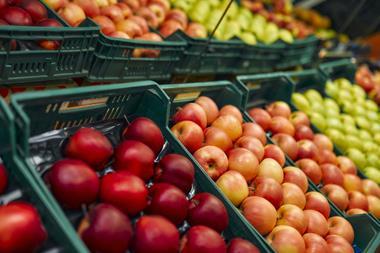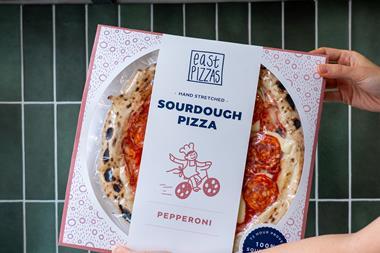The way we buy food in the UK is undergoing a fundamental change. Where once most customers were wedded to one big Saturday morning shop at the supermarket each week, today a ‘little and often’ approach means that smaller c-stores could well have a competitive advantage over the out-of-town superstores.
And some ambitious retailers, such as Avtar Sidhu from Sukhi’s Simply Fresh in Kenilworth, Warwickshire, are eager to use this opportunity to steal more market share from the supermarkets. His not-so-secret weapon? The chiller section and the everyday dairy products at its heart.
“I think that in the past the chiller is where the c-store sector has been really out-paced by the multiples,” he says. “But now, in our store we’re able to say: ‘Come on in guys, you don’t need to go to the supermarket, we’ve got the range of products that you want’. When customers come in here they see we can meet 90% of their needs. A well-stocked chiller cabinet is all part of that.”
In total Avtar devotes about seven 3.75m shelves to chilled dairy, stocked with a closely categorised offer which covers a wide supermarket-like selection following the basic to premium ‘good, better, best’ principle.
Make dairy deliver
Müller Dairy’s tips for c-stores:
Trade up. Convenience stores over-index on indulgent lines so include luxury yogurts and desserts to drive impulse treat sales
Make it easy to eat. Stock spoons in spoon holders at the chiller to remove barriers to instant consumption
Merchandise ‘Saint to Sinner’. Provide a good selection of different flavours, and group sectors such as ‘healthier options’, ‘everyday’ and ‘indulgent’ together to improve the overall shopping experience. Start shelf flow with natural, healthy products and move to luxury and full fat.
Put products face up. Merchandising this way has been shown to create a 10% uplift in sales.
This means that customers are able to come in and buy everything from natural yogurt and crème fresh to luxury clotted creams and everything in between.
“So in yogurts we’ve got Greek yogurts and natural yogurts, plus the children’s side of things such as Frubes,” he says.
“Then we go premium with brands such as Rachel’s, which leads on to the premium indulgence range that we do, with lines like Gü.”
As you might expect, Avtar’s approach is governed by a carefully customer-centric method which means constantly analysing epos data and retiring poor-selling products while always keeping a lookout for anything new and exciting from the sector.
The range has been “planogramed and re-planogramed” with input from a chilled expert to bring in some outside expertise and check that the offer is meeting customers’ needs.
“There is a danger here,” admits Avtar. “You could ultimately be providing too big a range. But I don’t look at it like that - I see it as building in a bit of positive waste into our business plan. So, we’re investing in stock today for the future growth of our business to give the customers what they want.”
Avtar’s investment in dairy as a key part of the chilled category is backed up by topline data.
“According to Mintel, 66% of those who regularly shop in the convenience channel state dairy products, including cheese and spreads, as their most frequent buy,” says Amy Fisher, central shopper marketing manager at Dairy Crest.
“In 2014, dairy sales topped £6.5m in the in-home convenience food total buys (Mintel). Even with shoppers using an ever-greater repertoire of channels to buy their groceries the convenience channel continues to perform well and is predicted to grow.”
What’s more, according to HIM Research & Consulting’s latest CTP research, chilled dairy is the fourth most purchased category within convenience.
“It’s an incredibly important category to drive footfall and increase basket size and spend,” says HIM research director Blake Gladman.
“When you look at a breakdown of the components in dairy, milk is still the biggest element. Milk is also the third highest driver to store from a product perspective, behind tobacco and newspapers -which highlights its importance as a footfall driver.”
He continues: “The key [in dairy] is to drive the basket size within the top-up shopper mission. Milk is a product that’s always going to be vital to drive footfall and single purchases, but the key to growing sales in the chilled dairy category is to up-weight the top-up basket with additional products, such as cheese, yogurts, butters and spreads. Fresh categories are very emotive and trust is a very difficult thing to win back when it’s been lost by a shopper, so first impressions count when it comes to a successful chilled display.”
Thanks to supermarket price wars and tumbling prices the margins on milk are never going to be inspiring - but it’s still one of the c-store sector’s ultimate must-stocks. Plus, as well as providing an everyday essential it can also be a canny way to help highlight what makes your store different.
Local can play a role
At Samantha Coldbeck’s Wharfedale Premier store in Hull, she’s determined to support local producers where possible, and that definitely includes those that sell milk.
“When you talk to customers they already realise how dairy farmers are being done down on price by the supermarkets and that some are really struggling,” she says.
“So we offer milk from Elmfield, a dairy that’s local. People really like the fact that it doesn’t come from miles and miles away - they want to support the independents, when it’s at the right price.”
Most c-stores would never be able, or willing, to match the mults on the price of milk and, as Samantha points out, it would be counter-intuitive to do so.
“As much as anything it’s basically a storage issue,” she says.
“If we reduced prices and increased volume we’d have to find somewhere to store it all! However, with other dairy lines, such as spreads, we do offer a promotion when it’s available.”
Though going large on chilled dairy may help put c-stores in the big leagues, it also can be much more difficult to maintain than other categories in-store.
“With any ambient product, such as a can of baked beans, it’s just put on the shelf and then stays there until a customer comes and puts it in their basket,” explains Avtar. “There’s no extra work needed. Chilled is much more labour intensive than the ambient category, but it’s ultimately crucial to basket spend.”
Much of this extra investment is about keeping the dairy cabinet looking neat and ultra clean. This is important in big stores that focus on chilled, but is just as crucial even if you have a more modest selection.
A good spread
Brands are busy adding extra value to c-store favourites such as buttery spread. Utterly Butterly, for example, now has a £1 pricemarked 250g variant, available in cases of eight, to specifically target shoppers on a top-up mission.“With an overtrade through convenience retailers, Utterly Butterly is valued at £22.8m (IRI). Utterly Butterly 500g is the second top-performing spread SKU in the convenience channel,” says Amy Fisher, central shopper marketing manager at Dairy Crest.Classic butter is also aiming to take a bigger share. Once considered the old-fashioned and unhealthy black sheep of the dairy category, butter is most definitely back with a bang.Mintel confirms butter is currently outperforming spreads, with the ‘natural factor’ and taste among the key drivers for consumers.This sea change is bringing some new players to the category, with Müller Wiseman Dairies entering the fray this year with its new c-store-ready 250g butter packs.“The impact of investment in butter-making is starting to have a significant impact on the dairy trade imbalance,” says Müller Wiseman Dairies managing director Carl Ravenhall. “In the past year, our first year in butter making, [butter] imports dropped by 10% and exports increased by 37%.”
At Spar Leegomery, Stacey Best says that dairy accounts for an average of 11% of total sales.
“We have a limited selection of dairy products, based around what people need,” she says.
“We have the most popular, so cheese, spreads, yogurts and desserts - everything customers expect from a c-store. It’s mainly top-up and people who are going out for the day that come in and grab something.
“You’ve got to make sure everything’s looking clean and tidy. Make sure that all the stock is looking really fresh - and if you get anything from the suppliers that you wouldn’t buy yourself, then don’t put it out!”
As is standard in most stores, a strict cleaning rota at Stacey’s store ensures that the milk section gets cleaned every day.
“You have to keep an eye on it. It’s high turnover and it can easily get dirty because there’s just so much footfall around it,” she says.
Avtar agrees that the right cleaning regime, along with sensible stock rotation, is essential, especially since the state of the chillers often signposts what customers can expect from the rest of the store.
“Customer experience is so important and it’s essential that everything looks attractive if you want to make your store a destination for chilled,” he says.
“The milk area needs the most attention. If you don’t clean it then dried milk starts to build up. If you don’t do that then it’s definitely going to put customers off.”
So, a bit like food to go, chilled dairy might take a bit of investment to get right, but in the right store it’s got the potential to really boost profits. And anyway, a category that features a true customer must-have like milk is worth paying extra attention to if you feel it’s being overlooked.
“With chilled dairy it’s a real growth area for us and it’s something we’ve really gone large with in the past three years,” says Samantha.
“You can see that people are using the supermarkets less and doing more shopping day-to-day. So, for small retailers, there’s the opportunity to boost sales by offering a similar kind of range to what’s offered on the high street.”
Moo-free dairy
Strangely enough, one of the soar-away sectors in the dairy cabinet comprises products that contain no milk or dairy at all. According to Mintel, lactose-free and dairy-free sales rose by 15.3% and 15% respectively in 2014, making the free-from sector one to watch carefully for the future.
Dairy brands are eager to get in on the act - Philadelphia is the latest to get a lactose-free variant this year in an attempt to bring in incremental customers - and some stores are busy making space in the chiller for this growing category.
“Free-from is a movement that is gathering pace and on the edge of entering the mainstream,” says Avtar Sidhu at Sukhi’s Simply Fresh in Kenilworth, Warwickshire.
“It’s a category stores such as Waitrose have gone to town on and by stocking the products it feels like we’re tapping into a movement that’s growing.”
To meet customer needs he stocks a large range of Alpro products, plus well-known health store brands such as Rude Health and Rice Dream.
“Before, people would have to go to a speciality store, but now we’re getting known for it customers understand they can come to us, ” says Avtar.
In Brief
Babybel on TV
BabyBel is back on the small (and big) screen with a new marketing push around its new SuperCheese character.
Expect in-store promotions and plenty of digital exposure around the caped crusader for the rest of the year.
Collectible cows from Dairylea
What’s black and white and set to speed all over your counter-top? The new Dairylea Moo-ing Racers - which are being given away as part of an on-pack promotion until the end of October. Udderly ridiculous, but set to inject some fun to the dairy category.
Frijj milkshake made more appealing
Frijj has dialled down the decadence of its milkshake range with a parent-pleasing 40% less sugar variant available in 471ml bottles.
Two flavours are available so far: Choc-a-Chocolate; and Seriously Strawberry. Flavoured milk is a tempting category, enjoying an 8.2% sales growth in convenience, according to IRI.
Danio hungry for attention
Strained yogurt brand Danio has launched its #HungerCry campaign. Targeting 18-34 year olds, the campaign kicked off on social media, followed by print ads and video on demand activity.
Mixing it up
It’s gone all Mediterranean over at Müller with its new remixed dessert, Müller Rice Remix: Greek Inspired. It adds a spicy cinnamon twist to rice, with strawberry or apple compote in a convenient twin-pot. It comes in singles, four-packs and six packs, rrp 69p, £2.69 or £3.89.
Source
Matt Chittock
































No comments yet